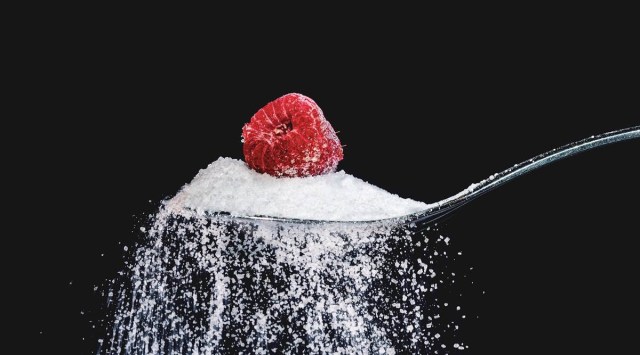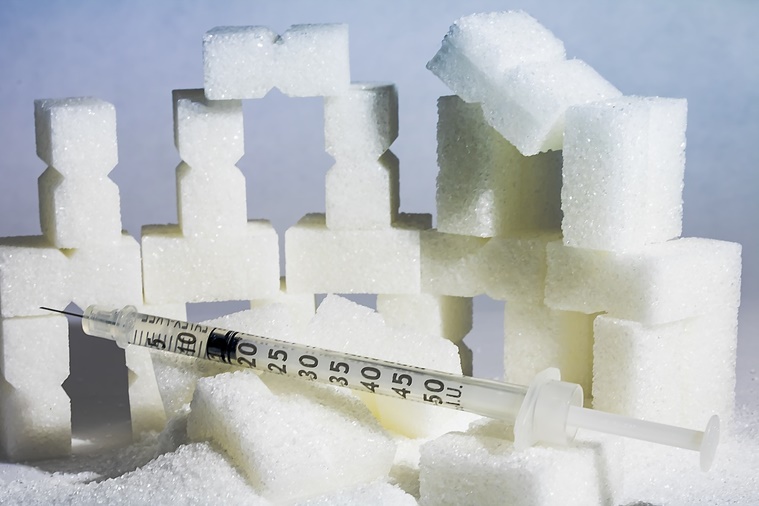- India
- International
Effective dietary rules to help control blood glucose in diabetics
Lifestyle intervention can only do as much and patients usually require effective medical therapies to optimise risk factor control in diabetes, said Dr Vishal Gupta
 It is important to keep a tab on sugar consumption. (Source: Pixabay)
It is important to keep a tab on sugar consumption. (Source: Pixabay)The goal of medical nutrition therapy in type 2 diabetes mellitus is to regulate the amount of carbohydrate, cholesterol and salt consumption to help optimise glycemic control, lipid (cholesterol) and blood pressure control. Lifestyle intervention can only do as much and patients always require effective medical therapies to optimise risk factor control in diabetes, said Dr Vishal Gupta, director of VG-Advantage diabetes thyroid and endocrine Centre, Mumbai, and consultant endocrinologist at Breach Candy Hospital and Research Centre, Mumbai.
Monitor daily calorie intake
For the normal weighted diabetic with BMI 18-23kg/m2, the aim is to maintain the body weight by consulting an average of 1,200–1,500 kcal per day for women, and 1,500–1,800 kcal for men. In order to lose weight, one must consume a 500–750 kcal/day energy deficit dietary plan, said Dr Gupta, who is also the author of Beyond Type 2 Diabetes Mellitus.
Monitor daily carbohydrate consumption
Focus on the intake of carbohydrates from vegetables, legumes, fruits, dairy products, and whole grains. Strongly discourage the diabetic patient or minimise the consumption of refined carbohydrates such as white flour, white rice, “low-fat” or “non-fat” food products with high amounts of refined grains, table sugar and sugar-sweetened beverages like soft drinks, he mentioned.
The WHO recommends that sugar intake be reduced to 5 per cent of the total calorie intake which is 25 grams of sugar per day for an average-sized person. It is seen that the average adult in India consumes approximately 58 grams of sugar daily.

 Effective rules to help control blood glucose in diabetes. (Source:Pixabay)
Effective rules to help control blood glucose in diabetes. (Source:Pixabay)
Monitor the quality of carbohydrate consumed
Glycemic index (GI) refers to the quantitative assessment of the post-meal blood glucose response of certain foods, which is expressed as a percentage. So higher the glycemic index, greater is its ability to raise the patients’ blood glucose.
Foods with a GI score over 70 are referred to as high glycemic, which is fast release of carbohydrate and higher post-meal blood glucose response. Foods with a GI score of 55 or less are referred to as low glycemic which help in slow release of carbohydrate and lower post-meal blood response. For example, white rice has a GI close to 93 as do commonly consumed biscuits versus brown rice which has a GI of 50.
 Monitor the quality of carbohydrates consumed. (source: Pixabay)
Monitor the quality of carbohydrates consumed. (source: Pixabay)
Consume carbohydrate along with fibre and protein
Dietary fibers can be described as any non-digestible carbohydrates that cannot be broken down in the upper food tract, thus helping reduce the GI of foods.
For examples, soluble dietary fibre in fruits, berries, certain vegetables i.e., pectins from guava, carrots; beans, lentils; nuts; germ fraction from oat and barley products, and psyllium. Insoluble dietary fibre include whole grain and bran products; skins of fruit; cucumbers, tomatoes; hull of grains; brown rice; legumes; nuts, almonds. “High dietary fibre intake has shown to result in a 20–30 per cent decrease in future risk of type 2 diabetes and lower the post-meal glucose excursion,” said Dr Gupta.
Protein ingestion has appeared to stimulate insulin secretion and cause a decrease in post-meal glycemic response. When dietary protein (e.g. leucine) is ingested along with glucose, it helps in reducing the post-meal glycemic response by 50 per cent.
Similarly, the co-ingestion of soya protein along with rice has shown to reduce the post-meal blood glucose response. With regards to protein intake in diabetic patients without diabetic kidney, the average daily protein intake can be up to 1–1.5 gm/kg bodyweight per day or 15–20 per cent of the total calories. Whereas, for those with diabetic kidney disease, the aim should be to restrict the daily allowance of protein to 0.8 gm/kg bodyweight per day.
Monitor the method of cooking
Dr Gupta explained that potatoes generally have one of the highest GI values of any food. Baking a potato may offer an advantage over boiling as it involves less cooking of its internal part, thereby helping to reduce the digestibility of potato.
“The average GI of canned potatoes is almost 36 per cent less as the preservation method that involves placing foods in jars or similar containers and heating them to a temperature that destroys microorganisms which spoils the food. Canning of starch-rich foods such as potatoes could decrease the GI. Cooling can also lower the GI of the food as it helps reform the crystalline structure of the carbohydrate known as ‘Retrogradation’ thereby reducing the GI,” he said.
For example, pasta cooked hot and fresh has a high GI but upon refrigeration or cooling and consuming the next day, the GI reduces substantially. Cooking Indian basmati rice in a microwave oven compared to a rice cooker lowered the GI by 20.4 per cent, he mentioned.
However, the problem that remains despite all these different cooking methods is the absolute increased carbohydrate consumed by the average Indian diabetic.
Efforts must be taken to improve health-related outcomes, especially in India, and from the evidence it is clear, that by limiting both total carbohydrate intake and foods with high GI, not only weight but also all indices of metabolic health can be improved, he stressed.
For more lifestyle news, follow us: Twitter: lifestyle_ie | Facebook: IE Lifestyle | Instagram: ie_lifestyle
May 18: Latest News
- 01
- 02
- 03
- 04
- 05

























